For the 2025 school year, there are 2 public preschools serving 974 students in Berlin School District. This district's average pre testing ranking is 6/10, which is in the top 50% of public pre schools in Connecticut.
Public Preschools in Berlin School District have an average math proficiency score of 50% (versus the Connecticut public pre school average of 35%), and reading proficiency score of 63% (versus the 42% statewide average).
Minority enrollment is 22% of the student body (majority Hispanic), which is less than the Connecticut public preschool average of 59% (majority Hispanic).
Overview
This School District
This State (CT)
# Schools
5 Schools
345 Schools
# Students
2,622 Students
132,954 Students
# Teachers
220 Teachers
10,546 Teachers
Student : Teacher Ratio
12:1
12:1
District Rank
Berlin School District, which is ranked within the top 50% of all 197 school districts in Connecticut (based off of combined math and reading proficiency testing data) for the 2021-2022 school year.
The school district's graduation rate of 94% has stayed relatively flat over five school years.
Overall District Rank
#80 out of 200 school districts
(Top 50%)
(Top 50%)
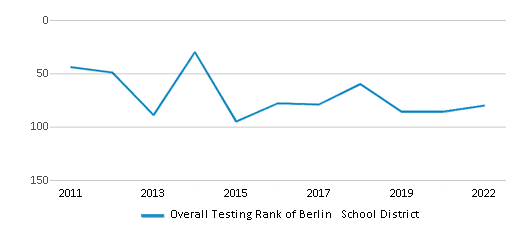
Math Test Scores (% Proficient)
51%
40%

Reading/Language Arts Test Scores (% Proficient)
61%
50%
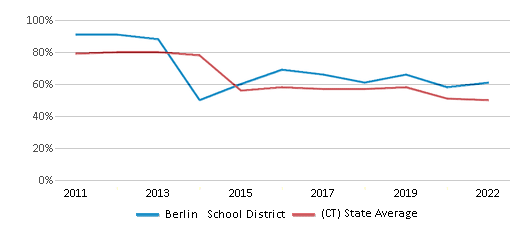
Science Test Scores (% Proficient)
58%
47%
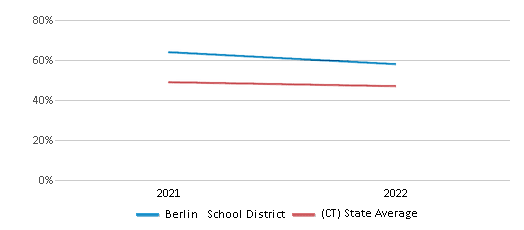
Graduation Rate
94%
89%

Students by Ethnicity:
Diversity Score
0.39
0.70
# American Indian Students
1 Student
381 Students
% American Indian Students
n/a
n/a
# Asian Students
108 Students
6,332 Students
% Asian Students
4%
5%
# Hispanic Students
358 Students
44,965 Students
% Hispanic Students
14%
34%
# Black Students
71 Students
19,832 Students
% Black Students
3%
15%
# White Students
2,012 Students
54,707 Students
% White Students
77%
41%
# Hawaiian Students
2 Students
132 Students
% Hawaiian Students
n/a
n/a
# Two or more races Students
68 Students
6,568 Students
% of Two or more races Students
2%
5%
Students by Grade:
# Students in PK Grade:
60
14,518
# Students in K Grade:
170
19,819
# Students in 1st Grade:
191
19,906
# Students in 2nd Grade:
202
20,278
# Students in 3rd Grade:
188
15,997
# Students in 4th Grade:
185
16,056
# Students in 5th Grade:
201
13,209
# Students in 6th Grade:
206
5,100
# Students in 7th Grade:
184
3,978
# Students in 8th Grade:
200
3,865
# Students in 9th Grade:
206
67
# Students in 10th Grade:
196
64
# Students in 11th Grade:
239
43
# Students in 12th Grade:
194
54
# Ungraded Students:
-
-
District Revenue and Spending
The revenue/student of $26,066 in this school district is less than the state median of $26,157. The school district revenue/student has stayed relatively flat over four school years.
The school district's spending/student of $24,786 is less than the state median of $25,225. The school district spending/student has stayed relatively flat over four school years.
Total Revenue
$68 MM
$12,920 MM
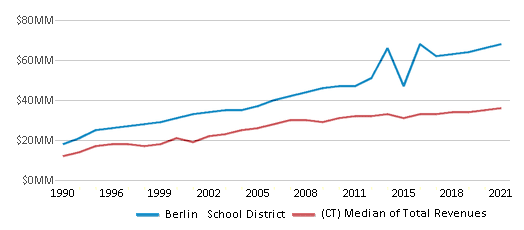
Spending
$65 MM
$12,459 MM
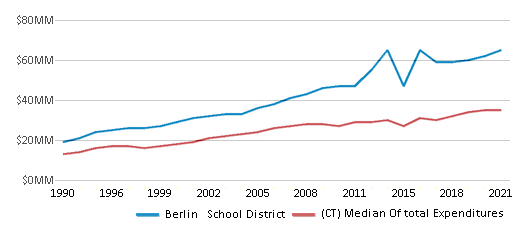
Revenue / Student
$26,066
$26,157
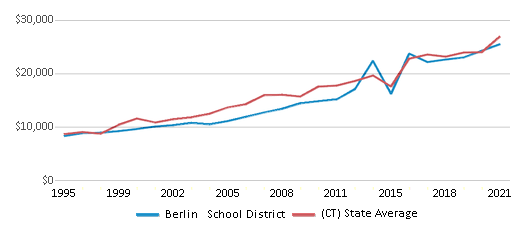
Spending / Student
$24,786
$25,225
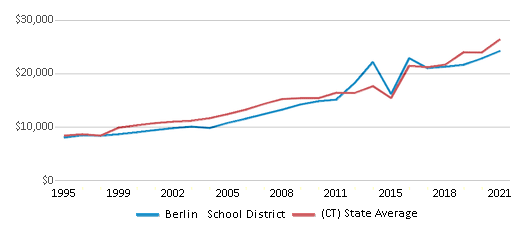
Best Berlin School District Public Preschools (2025)
School
(Math and Reading Proficiency)
(Math and Reading Proficiency)
Location
Grades
Students
Rank: #11.
Mary E. Griswold School
(Math: 53% | Reading: 67%)
Rank:
Rank:
8/
Top 30%10
133 Heather Ln.
Berlin, CT 06037
(860) 828-6336
Berlin, CT 06037
(860) 828-6336
Grades: PK-5
| 522 students
Rank: #22.
Emma Hart Willard School
(Math: 45-49% | Reading: 55-59%)
Rank:
Rank:
6/
Top 50%10
1088 Norton Rd.
Berlin, CT 06037
(860) 828-4151
Berlin, CT 06037
(860) 828-4151
Grades: PK-5
| 452 students
Recent Articles

Year-Round Or Traditional Schedule?
Which is more appropriate for your child? A year-round attendance schedule or traditional schedule? We look at the pros and cons.

Why You Should Encourage Your Child to Join a Sports Team
Participating in team sports has a great many benefits for children, there is no doubt. In this article you will learn what those benefits are.

White Students are Now the Minority in U.S. Public Schools
Increasing birth rates among immigrant families from Asia and Central and South America, combined with lower birth rates among white families, means that for the first time in history, public school students in the United States are majority-minority. This shift in demographics poses difficulties for schools as they work to accommodate children of varying language abilities and socio-economic backgrounds.





